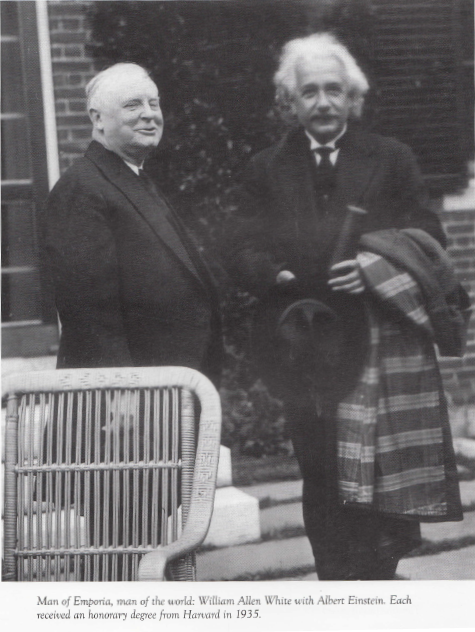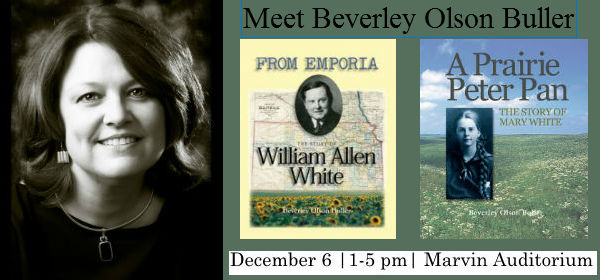Meet Beverley Olson Buller
To my delight, From Emporia opens with a photograph of Mr. White with one of my favorite historical figures, Albert Einstein. While White spent the first 27 years of his life in the Midwest, he went on to travel the world, became acquainted with ten presidents, and is still remembered today by schoolchildren throughout Kansas when they vote for the William Allen White Children's Book Award named in his honor. Children will enjoy getting to know the man behind their favorite book award, while adults will appreciate the story of a man who worked hard throughout his life and stayed committed to his convictions, playing an important leadership role in the anti-Klan movement in Kansas.
On the other hand, his daughter Mary's story ends in her tragic early death, but her life was immortalized by her father's essay in response to her death.
Readers can meet Ms. Buller in person at the upcoming literary fair, Great Writers, Right Here, on December 12 from 1-4 pm. Buller and other children’s authors will also be available to meet, sell, and sign books immediately before and after Real-life Author Storytime at 10:00 am.
Read on for an original interview with Beverley Olson Buller, conducted by e-mail in October 2014.
Warm-up Questions:
What is your favorite color? Red
If you could be any animal, what would you be? A cat
What are some of your favorite children’s books? Scat! Scat! was my very favorite book as a small child. It was about a little white kitten that needed a home. I still treasure it. My mother read the Laura Ingalls Wilder and C.S. Lewis Narnia books as well as Charlotte’s Web to me when I was quite young. As I grew older, I remember reading all the Lois Lenski books in the library as well as The Secret Garden and so many others. I still love children’s books and am blessed to be able to have spent my adult life surrounded by them.
Tell us a bit about your childhood. I grew up in Winfield, KS, and from age four lived quite near a Crayola crayon factory. My father was a dentist and my mother did a lot of volunteer work. I was able to walk to and from my elementary school each day with other neighborhood kids. We played outdoors a lot and had the most fun when it snowed. The thing I wanted most was a baby sister, and in December of my sixth grade year, our family adopted her—the best Christmas gift I ever got.
Tell us a bit about other careers you’ve had. I worked in that Crayola factory packing or labeling crayons all through college when I’d come home for the summer. Once I graduated from college, I went straight to work as a teacher, eventually going to library school so I could serve as a children’s librarian. Nearly ten years ago, I began work on my first book and have made non-fiction writing my second career now that I’m retired from teaching.
Questions About Your Books:
Why did you decide to write books about the White family? Kansas’s children’s choice book awards program is named after William Allen White. There was no book for children about Mr. White, so I researched and wrote the sort of book my own students would like to read. The story of White’s daughter, who died in a horse accident, haunted me, so I researched and wrote it for a younger audience than my first book. The Whites had an adopted granddaughter, and I’ve also written her story, but it hasn’t found a publisher yet.
Tell us about how you became an author. In 2005, I went to the grand opening of Red Rocks, the home of William Allen White, in Emporia and realized if there was to be a book about him for children in the gift shop there, I might as well write it! I decided that very day to write the book.
Tell us some of the hardest parts of writing a book. Much of writing is revision, which I do like, but it is very time-consuming. Since I write non-fiction, I also have to spend a lot of time gathering information and confirming facts used in the book. Sometimes it feels like that part of the process will never end—but I don’t want anything in the book to not be accurate. I have to stick with it until it’s done, no matter how long it takes.
Tell us some of the easiest parts of writing a book. For me, that’s probably getting the idea to write it. I’ve felt driven to write my books; there was no question that I wouldn’t write them.
Tell us a bit about your writing process. Since I write non-fiction, I start with research. First I read all the secondary sources (in William Allen White’s case, that meant lots of biographies written by other people) to get an overview of my subject. Once I feel I have a good sense of the subject, I move to primary sources. I can read a letter or a newspaper article from the time and be able to understand how it fits with the subject because I’ve already read a lot about their lives. It puts the primary sources in context. Of course, it’s much more fun to research with old letters, photographs, and things the subject left behind, but the foundation the secondary sources provide is important. I do some sort of organizing early on; I actually outlined my first book and did consult it as I wrote. Even though it was shorter, my second book was much more difficult to write because I couldn’t find the best way to tell Mary’s story until I finally just let the words of her father provide a framework. Then all the information that I’d gathered in my head just flowed out to fit that framework. Once I finish a chapter or a section, I read it aloud to myself and then work with sections that don’t sound right to me until they do sound right. I also catch grammatical and mechanical errors when I read my writing aloud.
Questions About Promoting Literacy:
How do you honor reading and writing in your home? Our home is filled with books, of course, and readers, in statue form or in prints on the wall. My laundry room has book wallpaper, our refrigerator has magnetic letters spelling out READ on it, and my office is full of items that inspire me, including the antique typewriter pictured on my website.
Tell us about a teacher or mentor who made an impact on you. I had a number of strong teachers from elementary school on who stressed literacy and helped me to learn to appreciate the art of putting the right words together. In high school, my English teachers made a great impact. It was wonderful sharing my first book with two of them. My mother no doubt had the greatest effect on my desire to write and to be a teacher as she also loved to read and read aloud to me so much in my childhood.
What is your favorite book to read aloud? I love to read aloud a well-written book so I can savor it and hopefully allow others to do as well. I used to read aloud A Christmas Carol to my seventh grade English classes each December; I still miss doing that.
What advice do you have for the parent or teacher of a child who does not want to read? My professional motto: Every child can learn to love reading if they find the right book. Don’t give up having them try different books until they find the one they can’t put down—and then be ready with the next book like it. (Ask a good librarian for a book list.)













